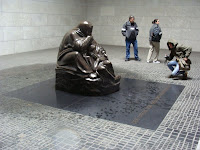This is a photo of a photo of a photo of Brandenburger Tor (Brandenburg Gate). We took our own photos of the gate, but in this one, you see what the square looked like after the WWII bombing of Berlin.
The cobblestone line in the street marks where the Berlin Wall stood less than 20 years ago. It is hard to imagine there being a barrier in this vibrant part of the center city (this photo was taken just behind Brandenburger Tor).
Nearby, a section of the wall.
Berlin's Holocaust Memorial covers an entire city block in the middle of town. Each column is approximately 1 meter by 2 meters, with the tallest column at 4 meters. The ground plane undulates and as you walk between the columns, it is quiet, disorienting, maze-like...it is easy to lose sight of the other people around you that you know are there but you cannot see.
There are two large public art pieces outside the old Luftwafa headquarters. Our guide stands in front of the first piece: a large Americanesque Regionalist mural that the DDR commissioned to show the state of the nation as they preferred to see it-wheat harvesting, industry, doctors, children smiling, dancing. The second piece is a large glass photo mural placed in the courtyard to look like a reflecting pool. The photo shows a mass of people behind a barricade, linking arms in solidarity. It's an archival photo of one of the first popular revolts against the DDR, taken at the same time the more optimistic mural was commissioned.
The infamous book burning square, where early in the rise of the Nazi party, the adjacent university library was purged of all books that contradicted Nazi ideology.

A Kathe Kollwitz sculpture at the Memorial for all Victims of War and Tyranny. From the outside, it looks like a greek temple, inside is bare except for the sculpture and a large occulus in the ceiling (letting in the rain on this day).

This church was built @100 years ago, styled to look older. On the right is the famous Berlin radio tower. We ended our tour huddled underneath one of the church porticos (it was pouring), listening to Paul share the sequence of events that led to the fall of the Berlin Wall. It was an amazing story of organizing at churches in Leipzig, leading to larger gatherings there and around other East German cities, a press conference gaff, and people, people, people. It was powerful. Check out:
http://www.youtube.com/watch?v=wSnkJXBq_dk
http://www.youtube.com/watch?v=wnYXbJ_bcLc

The Reichstag. It's hard to see but there is a modern glass dome atop the center of the building which is open to the public late into the evening. The dome symbolizes the transparency of the new unified German government--it is where the people can watch over parliament, and parliament is reminded of who holds the power.

Writing this blog, we are filled with love for humanity, peace, and the power of people. We were amazed by Berlin.

A Kathe Kollwitz sculpture at the Memorial for all Victims of War and Tyranny. From the outside, it looks like a greek temple, inside is bare except for the sculpture and a large occulus in the ceiling (letting in the rain on this day).

This church was built @100 years ago, styled to look older. On the right is the famous Berlin radio tower. We ended our tour huddled underneath one of the church porticos (it was pouring), listening to Paul share the sequence of events that led to the fall of the Berlin Wall. It was an amazing story of organizing at churches in Leipzig, leading to larger gatherings there and around other East German cities, a press conference gaff, and people, people, people. It was powerful. Check out:
http://www.youtube.com/watch?v=wSnkJXBq_dk
http://www.youtube.com/watch?v=wnYXbJ_bcLc

The Reichstag. It's hard to see but there is a modern glass dome atop the center of the building which is open to the public late into the evening. The dome symbolizes the transparency of the new unified German government--it is where the people can watch over parliament, and parliament is reminded of who holds the power.

Writing this blog, we are filled with love for humanity, peace, and the power of people. We were amazed by Berlin.







